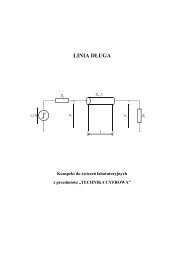9 Interlayer Exchange Interactions in Magnetic Multilayers
9 Interlayer Exchange Interactions in Magnetic Multilayers
9 Interlayer Exchange Interactions in Magnetic Multilayers
You also want an ePaper? Increase the reach of your titles
YUMPU automatically turns print PDFs into web optimized ePapers that Google loves.
342 9 <strong>Interlayer</strong> <strong>Exchange</strong> <strong>Interactions</strong> <strong>in</strong> <strong>Magnetic</strong> <strong>Multilayers</strong><br />
an explicit and direct l<strong>in</strong>k between oscillatory IEC and quantum size effects such as<br />
are observed <strong>in</strong> photoemission.<br />
9.5 Asymptotic Behavior for Large Spacer Thicknesses<br />
In the limit of large spacer thickness, D, the exponential factor oscillates rapidly<br />
with ε and k, which leads to substantial cancellation of the contributions to the IEC<br />
because of the different electronic states. Because the <strong>in</strong>tegration over energy is<br />
abruptly stopped at εF, however, states located at the Fermi level give predom<strong>in</strong>ant<br />
contributions. Thus the <strong>in</strong>tegral on ε can be calculated by fix<strong>in</strong>g all other factors to<br />
their value at εF, and by expand<strong>in</strong>g q⊥ ≡ k + ⊥ − k− ⊥ around εF, i.e.:<br />
with:<br />
q⊥ ≈ q⊥F + 2<br />
2<br />
v +− ≡<br />
⊥F<br />
1<br />
v + ⊥F<br />
ε − εF<br />
¯hv +− , (24)<br />
⊥F<br />
− 1<br />
v − . (25)<br />
⊥F<br />
The <strong>in</strong>tegration (see Ref. [74] for details) yields:<br />
EF − E AF = 1<br />
<br />
Im<br />
2π 3<br />
d 2 i ¯hv<br />
k<br />
+−<br />
⊥F<br />
D rArBe iq⊥F D<br />
×F(2π kBT D/¯hv +−<br />
⊥F ), (26)<br />
where:<br />
F(x) ≡ x<br />
.<br />
s<strong>in</strong>h x<br />
(27)<br />
In the above equations, q⊥F is a vector spann<strong>in</strong>g the complex Fermi surface; the<br />
velocity v +−<br />
⊥F is a comb<strong>in</strong>ation of the group velocities at the po<strong>in</strong>ts (k, k + ⊥F ) and<br />
(k, k − ⊥F ) of the Fermi surface.<br />
Next, the <strong>in</strong>tegration on k is performed by not<strong>in</strong>g that for large spacer thickness<br />
D the only significant contributions arise from the neighbor<strong>in</strong>g critical vectors k α for<br />
which q⊥F is stationary. Around such vectors, q⊥F may be expanded as<br />
q⊥F = q α ⊥F −<br />
<br />
kx − kα 2 x<br />
κ α x<br />
−<br />
<br />
ky − kα 2 y<br />
κ α y<br />
where the crossed terms have been canceled by proper choice of the x and y axes;<br />
κα x and κα y are comb<strong>in</strong>ations of the curvature radii of the Fermi surface at (kα and (k α <br />
, k−α<br />
⊥ ).<br />
(28)<br />
, k+α<br />
⊥ )



